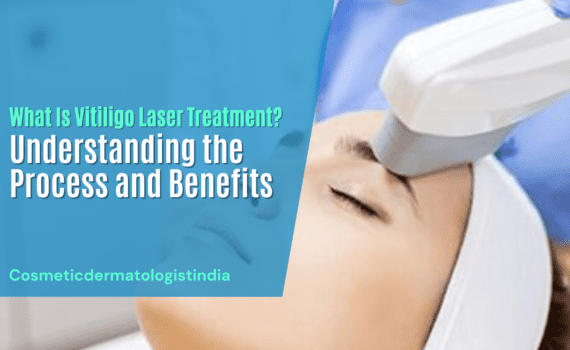
WHAT IS VITILIGO LASER TREATMENT? UNDERSTANDING THE PROCESS AND BENEFITS
WHAT IS VITILIGO LASER TREATMENT? UNDERSTANDING THE PROCESS AND BENEFITS
Vitiligo or Leucoderma is an auto immune disease that causes the skin to lose its natural colour. As a result, the skin appears white in patches. This condition can affect men, women and children and there is no known cause of it. The patches are formed because the disorders causes the melanocytes (pigment responsible for skin colour) to perish, leaving the skin with no pigment at all.
Vitiligo can affect any part of the body at any age. It can even be seen inside the mouth or on the scalp (changing the hair colour). White it is not a painful condition or itching or generally leads to any issues with physical functioning of the body, it can affect the mental health of the person greatly. People with vitiligo often feel self-conscious about the white patches and in some cultures it is also seen as a ‘curse’ causing a person to withdraw from the society. Vitiligo white patches are more visible in people with darker skin because of the stark contrast with the pigmented skin. The pale and discoloured patches of vitiligo can be seen most only face, neck, hands, and the skin folds.
What causes vitiligo?
The autoimmune cells in the body see the regular melanin producing cells as their ‘enemy’ and start killing the healthy pigment cells. One theory is that that it is possible that melanocytes self-destroy themselves and cause the skin to become pale. Vitiligo can happen any time up to the age of forty. Usually, it is small spot and that increases in time but there are no other symptoms. Scientists list many probable causes of vitiligo such as
- Genetic disposition
- Emotional distress or trauma
- Sun exposure and sunburn
- Addison disease
- Vitamin B 12 deficiency
- Anaemia
- Thyroid (hypothyroidism and hyperthyroidism)
- Type 1 diabetes
- Alopecia areata
Treatment for Vitiligo
Treatment for vitiligo is a purely personal choice. It is mostly done for cosmetic reasons. Laser is the most popular treatment option for re-pigmenting the skin. Vitiligo has a lot of stigma attached to it and in the Indian subcontinent where dark skin is more prevalent, people suffering from vitiligo are often made fun off because their appearance. Vitiligo patients are often treated differently because
- Lack of education and awareness about this un contagious skin condition
- It is often seen the same way as leprosy
- There is no known reason or a 100% cure for vitiligo
- Of half of the people suffering from vitiligo most develop it by the age of 20 and in rest it develops before the age of 40
- It is sometimes genetic and therefore most portions of the society feel it is cursed
- There is no way of determining whether vitiligo will spread as the time passes
There is a lot of uncertainty in the minds of the vitiligo patients regarding their looks and vitiligo treatment. Vitiligo patches are often looked down upon as dirty and disfiguring. In some cases, society has even gone to the extent of relating the white patches to past life dues.
Types of vitiligo
Depending on the severity of the vitiligo and the extent of body area affected by it, vitiligo is classified as
- Focal which affects only few area body and remains centred there.
- Segmental which affects only one side of the body
- Generalized vitiligo is characterized by loss of skin pigment all over the body and across the body in a symmetrical fashion
- Occupational vitiligo is a rare form of the condition and is caused because of exposure to industrial chemicals for example those used to make rubber.
Traditional temporary treatment methods for vitiligo include camouflage using makeup, dyes and tanners, topical steroid medicine and permanent ones includes surgery to replace the vitiligo patches. But each of these treatment methods has its own drawbacks and limitations. lasers have emerged as a more successful treatment for vitiligo that restores colour to the discoloured skin.
Laser treatment for vitiligo works in two ways
- If the patient has small patches of de pigmented skin then laser can be focused on the specific areas only.
- On the other hand if the vitiligo is wide spread then a special light chamber is used to expose the whole body to laser beam.
Laser helps by evening out the skin tone but it is also not a cure for vitiligo. There are different kinds of lasers that can be used and it depends on the individual’s condition and skin type. The most commonly used laser for vitiligo treatment is the Excimer laser.
Excimer laser
Also known as the XTRAC, the Excimer laser has some particular characteristics such as
- It uses UVB light for treatment
- The wavelength is 308 nanometres
- It is used to treat localized vitiligo
- This type of laser has been successful for patients whose vitiligo has responded well to other topical treatment methods.
- The laser does not expose the surround areas to radiation and treats only the affected patches.
- It even reaches the places which are difficult to reach with other treatments such as phototherapy.
- It is safe to use on children.
- It has been effective for more than 70% of people. However, the results are only effective for about a year.
- The results are visible a few months after the treatment.
The UVB light from the Excimer laser enhances the immune response of the body. This in turn triggers or stimulates the product of more melanocytes and the pale patches see a rise in melanin.
Laser is a painless procedure and each session takes only about half an hour to complete. Excimer laser is usually done in twice weekly session over a period of 4-6 months.
Side effects of Excimer laser
- It can cause blisters on skin
- It called reddening of the skin
- Results in hyperpigmentation or darkening
- Can cause skin lesions
The other lasers used for vitiligo treatment in Mumbai include
- Helium neon lasers
- Ti: Sapphire lasers
- UVA 1 lasers
- Fractional ablative lasers
- Q switched lasers
Every laser works differently and is chosen according to the disease’s specific characteristic such as location, activity, type and extent. For example
- Q-switched Nd:YAG lasers are considered safe and rapidly action and effective in depigmentation for most patients. It does not need any maintenance sessions. It is usually used in patients who have more than 80% depigmented areas or have an universal vitiligo (90% of depigmented area). This treatment is often used along with bleaching creams and sunscreen to give most effective results.
- Fractional ablative lasers create tiny microscopic wounds on the skin of the affected areas and trigger the immune system response to the injuries. This stimulates melanocytes cells in to production and helps cover the vitiligo affected areas. These are also used to improve the results of NB-UVB treatments.
- Fractional CO2 lasers cause the pale areas to contract and this can temporarily reduce the size of vitiligo patches
- Ti: Sapphire lasers are often used as an alternative to the excimer lasers.
Who is laser treatment for vitiligo suitable for?
- Lasers work for people with all age groups and skin tones.
- Some lasers might not work for children and children with extensive vitiligo are treated using narrowband UVB wavelength.
Aftercare after laser vitiligo treatment
Lasers do not require hospitalization and there is no need to take time off from work or a break from regular life but you will still need to take care of your skin by
- Avoiding sun and wearing sunscreen every time you are outdoors
- Gently cleaning the area twice daily
- Using the creams and lotions given by the dermatologist
- Avoid using retinols and glycolic acids on the skin till the time the laser sessions are on
- Keeping the treated area moisturized and regularly using lightening cream to maintain skin hydration and preventing changes in pigments.
- Staying away from treatments like bleaching, hair colouring, straightening, perming and facials.
- Avoiding tanning treatments etc for 4 weeks before the treatment.
Vitiligo laser treatment cost in India
The cost of vitiligo laser treatment in India depends on
- The extent of vitiligo spread
- The areas being treated
- The number of sessions needed to get the desired results
- The fees of the dermatologist
- The clinic costs
Vitiligo surgery cost in India much higher than the laser treatments. Surgery is only done for patients who have a stable vitiligo and rest of the treatments have not worked. Vitiligo surgery needs enough pigmented areas on the skin to cover the pale and white patches of the skin. Talk to the clinic about insurance coverage and payment plans regarding the laser vitiligo treatment.






